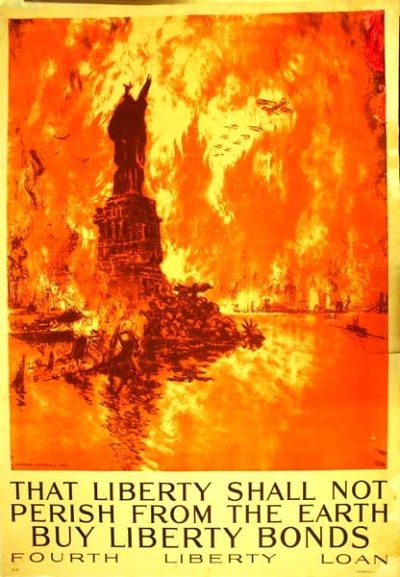http://www.flickr.com/photos/mfspeccoll/4902820387/in/set-72157624742434942
In the poster above one can very clearly see the harbor of New York City, the sky is engulfed in flame, the buildings are on fire and enemy planes circle the harbor. It is a scene of total chaos and collapse. Except for one thing. In the foreground, standing resolute and proud one can see the outline of the Statue of Liberty, backed by the fiery sky. At the bottom, the poster reads "that liberty shall not perish from the earth, buy liberty bonds". Those words are a modified version of a line from Abraham Lincoln's powerful Gettysburg Address. The original line reads “. . . that this nation, under God, shall have a new birth of freedom—and that government of the people, by the people, for the people, shall not perish from the earth". The line was rewritten so that instead of government perishing, it is liberty who falls. This line could be interpreted to indicate either the Statue of Liberty falling, liberty itself, or perhaps both and the message would have undoubtedly resonated with the American public at the time.
Even as a modern viewer of this scene, I am moved. This image, against my best intentions, stirs up a kind of patriotic fury inside me. I see the harbor burning and I grow indignant at the invading forces. How dare they come to our city! It took a second for me to realize that those feelings I was experiencing were exactly what the creators of that poster wanted me to feel. I'd been had essentially. That is when it hit me that the war posters were not really just about funding the war or finding recruits, instead they were an extremely powerful tool that could fuel the home front and maintain public support of the war. These posters were literally everywhere and were viewed by thousands and thousands of people. Their reach extended far beyond what modern advertisement does today because while ads for food or movies only appear in certain spheres of life, the war posters were seen not only in stores and public places, but in schools, churches, office buildings and vast numbers of other venues where the average ad does not reach. These war posters completely redefined the idea of public space and not necessarily for the better.
Because this poster was intended for an American audience, I am not certain how the Brittain readings correlate to the image. I do think that the idealism in the poster, the picture of destruction in the most famous city in our nation and the inclusion of a famous patriotic quote, would have stirred Vera and Roland to action, were they American. I think that the nationalism and idealism that spurred many young people to join the war efforts in her time are definitely evident in this poster and any number of young women like Vera could have been inspired to contribute to the war efforts because of this image.


Comments
Jack Welch
Mon, 02/04/2013 - 20:19
Permalink
I'm very interested in your
I'm very interested in your suggestion that "war posters completely redefined the idea of public space." Not only is it a striking thought, but it seems to me an effective way of conceiving the unprecedented public investment in this "total war." It pervaded all aspects of public life in a way that we're not used to thinking about anymore, and part of that lies in this redefinition of space, the fact that one literally couldn't get away from the idea of the war. At the same time that war propaganda was a unifying force, it must also have felt stifling and claustrophobic. One wonders if this inundation with images was the source of much revulsion or resistance, in the way that many of us reflexively dislike, say, Sarah McLachlan animal cruelty videos, or anything that tries to simplistically manipulate one's emotions or forcibly instill feelings of guilt. The fact that one could never really escape from war imagery while in a public place must have been a source of frustration for some.